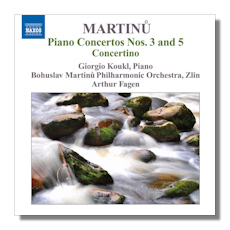
The Internet's Premier Classical Music Source
Related Links
- Martinů Reviews
- Latest Reviews
- More Reviews
-
By Composer
-
Collections
DVD & Blu-ray
Books
Concert Reviews
Articles/Interviews
Software
Audio
Search Amazon
Recommended Links
Site News
 CD Review
CD Review
Bohuslav Martinů

Piano Concertos, Volume 1
- Concerto #3, H. 316
- Concerto #5 "Fantasia Concertante", H. 366
- Concertino for Piano & Orchestra, H. 269
Giorgio Koukl, piano
Bohuslav Martinü Philharmonic Orchestra, Zlin/Arthur Fagen
Naxos 8.572206
Martinů certainly had a highly individual style: his music is instantly recognizable even if it exhibits characteristics associated with another composer or an earlier period. The Third Concerto begins with an orchestral introduction that offers hints of Stravinsky, from his neo-Classical period, but the music exudes Martinů in every measure still, both in its melodic/harmonic fabric and in its generally light orchestration. The piano enters and you soon hear those typical sweet/sour Martinů chords and that irrepressible joy, that chipper energy. Yet, there is a certain Brahmsian quality that shows through too, but it's vague.
It is less vague in the Andante poco moderato second movement and Moderato – Allegro finale, especially in the cadenza near the end of the latter panel. Whenever the music turns dark, it seems, the ghost of Brahms appears, often with those curt, slashing chords that wouldn't be out of place in a Brahms scherzo. Again, however, the music remains Martinů at its core: some listeners, in fact, may not quite notice the snatches of Brahms – and they are just snatches. Anyway, this is a fine work.
The Fifth Concerto, however, is even better. It is perhaps my favorite Martinů composition. The sunny first movement is filled with lovely dreamy moods and joyous themes, together infusing the music such beauty and delight. Some have compared this concerto with the Bartók Third, and while there's a spiritual similarity between both works' middle panels, the Martinů is brighter and, I think, the better piece. The composer wrote it in 1958, a year before he died, and was probably beginning to notice symptoms of the cancer that would soon take his life. Bartók, too, was at the end of his life when he was writing his Third Piano Concerto: he died before finishing it and a student, Tibor Serly (later a composer of some note), finished the last seventeen measures of the finale.
The finale of the Martinů Fifth (Poco allegro) divulges no sense of tragedy: it is a joyous, energetic piece, whose sort of oxymoronic mixture of eccentricity and youthfulness is simply infectious. This concerto should be much more popular, and might almost be considered alongside the concertos of Prokofiev and Rachmaninov. Almost. Though it lacks the longer lines and more assured piano writing generally found in those composers" works, it is nevertheless a clever creation, a work you can return to on repeated hearings to always find something new and memorable.
The Concertino, which closes out the disc, is another bright work, perhaps a rung or so below the concertos, but a worthwhile piece nevertheless. Cast in a three-movement slow-fast-slow structure, like the concertos, it is, at 21:29, briefer than either and a bit more percussive in its piano writing. The first movement opens in a dour mood, but the piano's pert rhythms and playful manner brighten things, and even if we get a mixture of clouds and sun, the mood never descends to the darker character of the ensuing Lento. Here, for once in a Martinů work, the music conveys a sense of gloom. The conflicted middle section mixes playfulness and dark struggle, with the latter seeming to win out. The finale invokes a brighter world: the Naxos notes by Mark Gresham and Cary Lewis, suggest a mixture of Rachmaninov and Gershwin and orchestration fit for Broadway. I won't dismiss that observation, but the music might better be viewed as festive Martinů, or Martinů celebrating with colorful moods peppered by a healthy measure of bombast.
In all works Prague-born, Lugano-based pianist Giorgio Koukl plays with a real sense for Martinů's individual style, deftly catching his quirkiness and bounce, his irrepressible joy and buoyant energy. I first became familiar with the Fifth Concerto from a 1979 Supraphon LP, on which Ales Bilek played the work. It was a fine performance, but this version is at least as good, not least because of the contribution of Arthur Fagen. Fagen, who has recorded all the Martinů symphonies, is a real master at obtaining the correct balances in the orchestral textures, and the Bohuslav Martinü Philharmonic Orchestra plays as if the spirit of the composer hovered above. The Naxos sonics are vivid and powerful. Highly recommended.
Copyright © 2010, Robert Cummings





















